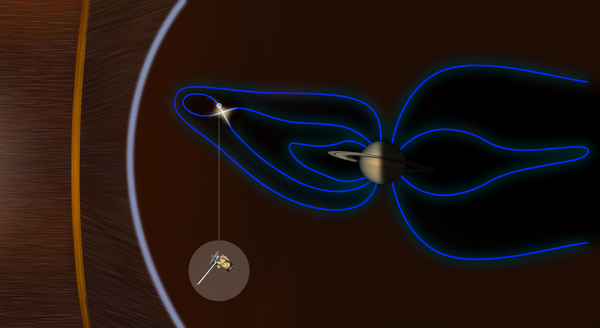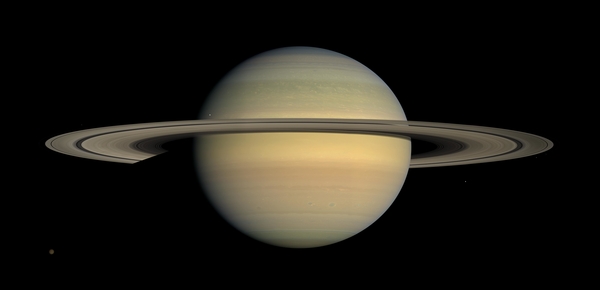Surprising magnetic reconnection spotted on Saturn's dayside
5 June 2018
Data from the international Cassini mission has revealed that a phenomenon called magnetic reconnection can occur on the dayside of Saturn, within the planet's magnetic environment. |
| Magnetic reconnection within Saturn's magnetosphere. Credit: ESA |
Reconnection happens when two magnetic fields collide – for example when the Earth's magnetic field is hit by the stream of charged particles released by the Sun as the solar wind.
The magnetic field around the Earth, generated as the planet's hot metallic core rotates, affects charged particles in the planet's environment, creating a magnetosphere. As the magnetosphere interacts with the flow of particles coming from the Sun, for example during a solar flare, the magnetic lines of Earth's magnetic field lines can temporarily break, on both the day and night side of the planet. When this happens, the magnetic lines connect with those from the incoming magnetic field, which changes their direction.
Magnetic reconnection is an explosive process that can connect magnetic fields between the solar wind and a planetary magnetosphere at their interacting boundary, known as the magnetopause, accelerating plasma to much higher energies as a result.
During this phenomenon, energy from the magnetic field can be transferred to the charged particles and accelerate them. These events can, on the one hand, trigger the beautiful spectacles of polar aurora. On the other hand, the charged particles can disrupt GPS signals, damage satellites or even electrical grids on Earth.
Inside the magnetosphere of Earth, reconnection mainly happens on the planet's night side, in the magnetotail. On the Sun-facing side, which is constantly battered by the solar wind, charged particles usually cannot penetrate the planet's magnetic field – although, on certain occasions, the magnetopause boundary can be pierced by reconnection happening at the boundary itself, letting solar wind particles in.
Scientists expected that magnetospheres of other planets would behave similarly to that of Earth, with magnetic reconnection taking place either at the magnetopause boundary or inside the magnetosphere – but in the latter case, only on the nightside.
However, in data obtained by the Cassini probe at Saturn in 2008, a team of scientists recently found, for the first time, evidence of magnetic reconnection occurring on the planet's Sun-facing side, well within the magnetopause boundary, in the so-called magnetodisc – the flattened distribution of plasma that surrounds Saturn and rotates along with it. Reconnection in the night-side magnetodisc had been seen before, but the new phenomenon was seen in the dayside magnetodisc, which was completely unexpected.
 |
| Saturn in July 2008. Credit: NASA/JPL/Space Science Institute |
The study, published today in Nature Astronomy, was led by Zhonghua Yao from the Space science, Technologies and Astrophysics Research Institute of the University of Liège, Belgium, and by Ruilong Guo from the Institute of Geology and Geophysics, Chinese Academy of Sciences, Beijing, China.
Spotting the occurrence was not an easy feat.
"To detect a reconnection event, you have to observe the change in the direction of the magnetic field following the reconnection, but also evidence of the subsequent acceleration of the particles," says Yao.
"This is not easy to measure because the region where the reconnection occurs is very small and the instrument needs to be pointed exactly in this direction. You have to be very lucky."
The researchers combined data from Cassini's magnetometer (MAG), which enabled them to detect the change in direction of the magnetic field, with data from the Cassini plasma spectrometer (CAPS), which measured plasma particles and was able to identify the particle acceleration caused by the magnetic reconnection.
But how is it possible for this phenomenon to occur on the planet's dayside well inside the magnetopause? Saturn's magnetosphere, like that of Earth, is much thicker on the dayside, which should protect it from outside interference.
The scientists believe that the observed magnetic reconnection is driven by a different mechanism. In Earth's magnetosphere, reconnection is caused purely by the interaction with the solar wind. On Saturn, the phenomenon might also be linked to the planet's own rotation.
"Saturn's magnetosphere has a different structure compared to Earth," says Yao. "The reason for that is that most of the magnetosphere of Saturn is rotating rapidly, unlike that of Earth."
Saturn, while more than 760 times larger than Earth in volume, completes one rotation in about ten hours, compared to Earth's 24 hours. As its magnetosphere rotates together with the planet, it constantly interacts with Saturn's rings and moons, and in particular with plasma from the active icy moon Enceladus. The chemical composition of Saturn's magnetosphere is also different compared to Earth.
"In the Saturn system, the moon Enceladus and its cryovolcanic activity eject a lot of water vapour and tiny icy dust grains," says Nicolas Altobelli, ESA Cassini project scientist.
"As this water gets ionised, it fills up the magnetosphere of Saturn with heavy ions that interact with the rotating magnetic field lines. When these lines change configuration, during a reconnection event for example, this plasma is released and accelerated."
In future years, the scientists expect to find more similar events in the treasure trove of data generated by Cassini, which concluded its mission last September with an epic plunge into the atmosphere of Saturn, having studied the planet and its environment for over 13 years.
"Now we know how to look and what to look for," says co-author Andrew Coates from University College London, UK, who is co-investigator of the Cassini CAPS electron spectrometer used in the study.
"So far we have only scratched the surface of what we can find with the CAPS instrument. Now we can look back through the data and see whether there are other examples. We have a very rich data set that will keep us busy for years."
These findings provide important insights into the behaviour of magnetospheres of fast rotating planets, of which Saturn is only one example, and the physics behind reconnection. It is possible that ESA's future JUpiter ICy moons Explorer, JUICE, will find similar phenomena in the atmosphere of the Solar System's largest planet.
"Jupiter also has a very rapidly rotating magnetosphere," says Coates, who is also co-investigator on the JUICE Particle Environment Package (PEP) instrument. "Instead of water from Enceladus, Jupiter has sulphur from its volcanic moon Io, so the JUICE mission might eventually be able to measure this new type of magnetic reconnection on the dayside magnetodisc as well, when it gets there in 2030."
"Jupiter is the next giant magnetosphere we are going to visit," adds Altobelli, who is also responsible for the development of JUICE science operations at ESA. "After all these years of analysis of Cassini data from Saturn, we will arrive at Jupiter with a much better understanding of what we should be looking for."
Uranus, Neptune, as well as many fast-rotating exoplanets beyond our Solar System, might also have magnetospheres that produce rotation-driven reconnections on the dayside magnetodisc.
"Seeing this phenomenon at Saturn, by analogy, we may just assume it happens at other magnetised, rapidly rotating planets with an internal plasma source as well," concludes Coates.
Notes for Editors
The paper "Rotationally driven magnetic reconnection in Saturn's dayside" by R. L. Guo, Z. H. Yao, et al. is published in the journal Nature Astronomy. DOI: 10.1038/s41550-018-0461-9
Cassini-Huygens is a cooperative project of NASA, ESA, and ASI, the Italian space agency.
For further information, please contact:
Zhonghua Yao
Space science, Technologies and Astrophysics Research (STAR) Institute
Université de Liège, Belgium
Email: zhonghua.yao![]() uliege.be
uliege.be
Andrew J. Coates
Mullard Space Science Laboratory
University College London, UK
Email: a.coates![]() ucl.ac.uk
ucl.ac.uk
Nicolas Altobelli
ESA Cassini-Huygens Project Scientist
Phone: +34 91 813 1201
Email: nicolas.altobelli![]() esa.int
esa.int


